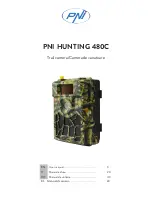PL-A780 Camera Specifications
13
PixeLINK PL-A780
Document No.: 04646-01
MACHINE VISION CAMERA
SYSTEM GUIDE
Copyright © 2004 PixeLINK
All Rights Reserved
3.2.4.1 Rolling Shutter
With a Rolling Shutter, only a few rows of pixels are exposed at one time. The camera builds
a frame by reading out the most exposed row of pixels (and ceasing exposure of that row),
starting exposure of the next unexposed row down in the ROI, then repeating the process on
the next most exposed row and continuing until the frame is complete. After the bottom row
of the ROI starts its exposure, the process “rolls” to the top row of the ROI to begin exposure
of the next frame’s pixels.
The exposure down each frame, and from frame-to-frame, remains consistent due to this
continuous read-out.
The row read-out rate is constant, so the longer the exposure setting, the greater the number
of rows being exposed, or integrated, at a given time. Rows are added to the exposed area
one at a time. The more time that a row spends being integrated, the greater the electrical
charge built up in the row’s pixels and the brighter the output pixels will be. As each fully
exposed row is read out, another row is added to the set of rows being integrated.
Example:
A very short exposure may be obtained by having only three rows of
integration (see Figure 7 below). This means that as each row is being read
out, the three rows ahead of it are being exposed. As each row is read out,
another row is added to the group of rows being integrated.
Figure 7 Rolling Shutter Integration and Read-Out
Because Rolling Shutter exposes rows in the integration area while reading out fully exposed
rows (that is, it does not stop exposure to perform read-out), it provides evenly exposed
image data with the greatest possible speed (under the given parameters).
Each row of pixels has a slightly different exposure start and end times from the adjacent
rows, so Rolling Shutter can produce a distorted effect when imaging moving subjects, even
with very short exposure times. The distortion is due to the comparatively lengthy process of
readout compared to exposure. For example, to readout the entire PL-A780 frame requires
approximately 250 milliseconds. While a short exposure may stop a moving object, the same
object can move appreciably in the quarter second that it takes to readout the frame resulting
in distortion in the direction of motion.
For best results, rolling shutter should be used with constant illumination and with a static
subject. If strobe illumination is required or the object is moving, the Fast Reset Shutter mode
should be used.
1
2
3
4
•
The arrowhead indicates the row currently being read out.
•
Dashed lines indicate inactive rows.
•
The three (solid) lines preceding the read-out row indicate the rows being integrated.


















